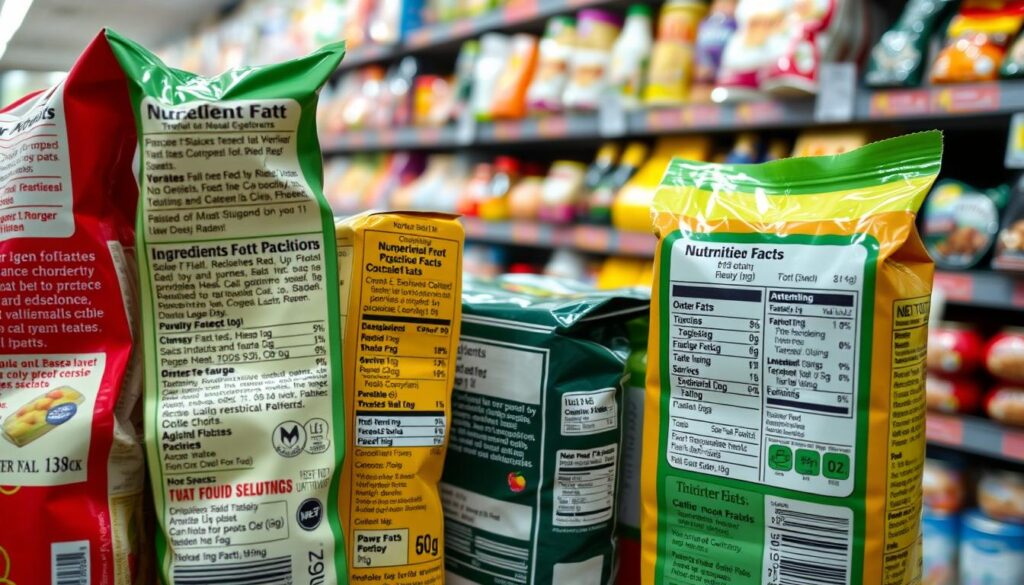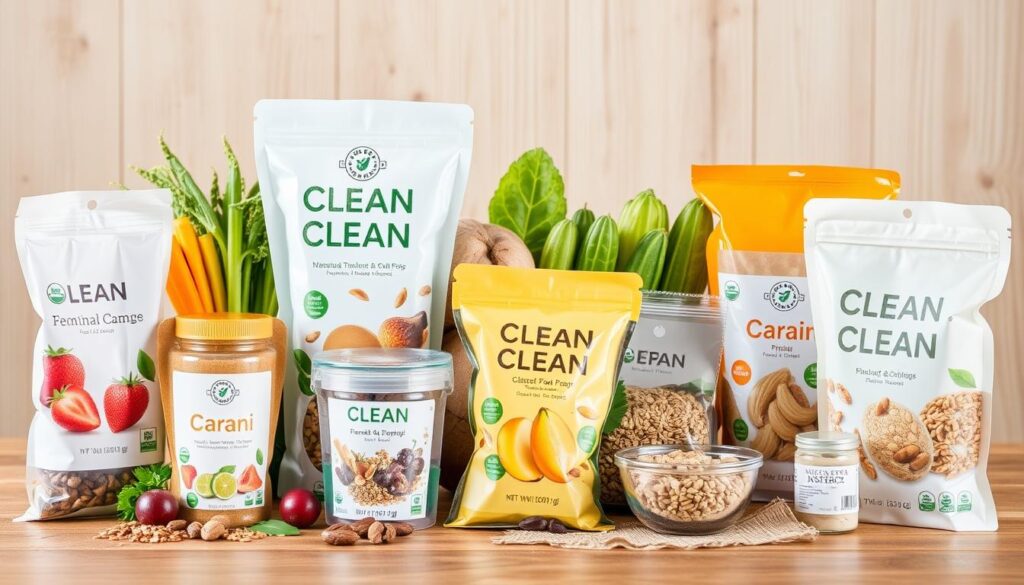In today’s world, we all want to know what’s in our products. We have the right to know what we put in our bodies and on our skin. But, with complex labels and hidden additives, it’s hard to know what to look for.
This article will help you understand the importance of knowing what’s in your products. We’ll talk about how to read labels and find out the truth about ingredients. You’ll learn how to make better choices as a consumer.
Key Takeaways
- Discover the FDA labeling guidelines and international standards for product disclosure
- Understand the rise of the clean label movement and its impact on consumer trust
- Learn to decipher common ingredient names and identify hidden additives
- Explore the importance of allergen information and supply chain transparency
- Uncover the latest trends in non-GMO verification and sustainable sourcing practices
Understanding Product Label Requirements
When we buy products for our homes, knowing what the labels say is key. Labels tell us about food, product details, and allergens. It can seem overwhelming, but we’re here to help. We’ll explain what labels must say and what’s optional.
FDA Labeling Guidelines
In the US, the Food and Drug Administration (FDA) makes rules for food labels. They require labels to show the product’s name, nutrition facts, ingredients, and allergens. This helps us make better choices about what we eat.
International Labeling Standards
But, labeling rules vary worldwide. For example, the European Union has strict rules about telling consumers about allergens. Knowing these rules is important for companies selling in different places.
Mandatory vs. Optional Disclosures
- Mandatory Disclosures: Labels must have nutrition facts, ingredient lists, and warnings about allergens.
- Optional Disclosures: Companies can add extra info, like if a product is sustainable or ethically made, to stand out.
By understanding food labeling, product disclosure, and allergen information, we can make smarter choices. This supports the transparency we want in our products.

The Rise of Clean Label Movement
In recent years, the clean label movement has changed the consumer goods industry. People now want simple, transparent, and ethically-sourced products. This trend makes brands rethink their formulas and marketing.
Long lists of hard-to-pronounce ingredients are no longer okay. Today, people look for clean label products. They want ingredient transparency and ethical sourcing. They’re choosing natural, less-processed options over artificial additives and preservatives.
This movement isn’t just for big brands. It’s also helping new startups shake up old industries. These startups show it’s possible to make quality, eco-friendly products without high costs.
Consumers are demanding more information about the products they buy, and they’re willing to pay a premium for brands that are transparent about their ingredients and sourcing practices.
As the clean label trend grows, companies can’t ignore what consumers want. They’re changing their products or starting new clean label lines. This is helping businesses meet the demand for these products.

By focusing on ingredient transparency and ethical sourcing, brands can gain trust and loyalty. The clean label movement is here to stay. Smart companies are finding creative ways to meet the demand for products that match consumer values.
Demystifying Common Ingredient Names
Understanding ingredient lists can seem like a puzzle. But don’t worry! We’re here to help you make sense of tricky chemical names and food labeling and ingredient transparency.
Chemical Names vs. Common Names
Many ingredients on labels have scientific-sounding names. But it’s not as scary as it seems! For instance, “ascorbic acid” is just another word for vitamin C. Knowing these common names makes reading labels easier.
Hidden Sugar and Salt Aliases
- Watch out for sugar names like “evaporated cane juice,” “maltose,” and “high fructose corn syrup.”
- Salt can hide as “sodium chloride,” “monosodium glutamate (MSG),” and “baking soda.”
- Being aware of these hidden ingredients helps you choose better.
Artificial vs. Natural Ingredients
In non-GMO and clean label products, knowing the difference is key. Artificial ingredients include synthetic preservatives and colors. Natural ingredients come from fruits, veggies, and minerals. Knowing this helps you pick better.
Once you know how to read them, nutrition labels can be a powerful tool for making informed choices about the food you eat.”
By understanding ingredient names, spotting hidden sugars and salts, and knowing the difference between artificial and natural, you’ll be a pro at food labeling and ingredient transparency. Armed with this knowledge, you can make smarter choices for your home.
Allergen Information and Consumer Safety
Food allergies are a big worry for many. It’s key to know what’s in our food. Now, labels must list common allergens like peanuts, dairy, and soy. This helps keep people with severe allergies safe.
New trends in labeling are helping even more. Some brands tell us exactly how much of each allergen is in their products. Others warn about possible allergen contamination from shared spaces.
| Allergen Disclosure | Mandatory | Voluntary |
|---|---|---|
| Common Allergens | ✓ | |
| Specific Allergen Quantities | ✓ | |
| Cross-Contamination Risks | ✓ |
These changes mean better allergen information and food labeling. It’s a big step towards keeping everyone safe. It lets people with allergies shop with confidence and avoid serious health issues.
Accurate and transparent allergen labeling is essential for the millions of people with food allergies. We’ve come a long way, but there’s still more work to be done to ensure everyone can shop with confidence.”
Supply Chain Transparency in Modern Manufacturing
Today, people want to know more about the products they buy. They want to know where the ingredients come from and how they were sourced. Luckily, companies are now using new ways to show where things come from.
They use traceability systems, blockchain technology, and third-party checks. This helps them show how they source their ingredients.
Traceability Systems
Traceability systems are changing how we track our food and other items. They use RFID tags, barcodes, and GPS to track products. This means we can see where our food comes from.
This supply chain transparency makes us feel more confident in what we buy.
Blockchain in Ingredient Tracking
Blockchain is also important for sustainable ingredients and ethical sourcing. It keeps a record of a product’s journey. This makes sure everything is tracked and honest.
This technology helps brands prove they’re using responsible practices.
Third-party Verification Methods
Companies also use outside groups to check their claims. These groups give fair trade, organic, and non-GMO certifications. This adds to the trust and confidence of health-conscious buyers.
As people want more transparency, smart brands are using these tools. They’re building trust and showing their values. This helps them connect with consumers who care about where things come from.
Ingredient Transparency: Impact on Consumer Trust
In today’s market, being open about ingredients is key to gaining trust and loyalty. People want products that are upfront about what they contain. Companies that are transparent are seeing big benefits.
A study found that 84% of consumers are more likely to stick with a brand that’s clear about its ingredients. This shift is because people value honesty and are wary of hidden information on labels.
Patagonia is a great example of how being open works. By sharing where and how their products are made, they’ve built a loyal following. This openness has helped them succeed for years.
But, hiding ingredients or making false claims can harm a company. For example, when a big cosmetics brand was found using secret synthetic chemicals, it caused a big scandal. This led to a big loss of trust from customers.
The bottom line is clear: being transparent about ingredients is essential for trust. By being open and honest, brands can stand out and connect deeply with their audience.
Non-GMO Verification and Product Labeling
Consumers want to know more about the foods they buy. The non-GMO movement is growing fast. Knowing how non-GMO verification works helps us make better choices at the store.
GMO Testing Methods
To check if a product is non-GMO, we need to test it well. We use DNA tests like PCR to find GMO DNA. These tests are done by labs that are not connected to the product makers.
Certification Requirements
- Products need to follow strict rules to get non-GMO certification.
- They must track all ingredients, test for GMOs, and keep them separate.
- They also go through regular checks to make sure they’re non-GMO.
Global GMO Standards
| Region | GMO Labeling Regulations |
|---|---|
| United States | Mandatory labeling for foods containing over 5% GMO ingredients |
| European Union | Mandatory labeling for foods containing any amount of GMO ingredients |
| Japan | Mandatory labeling for foods containing over 5% GMO ingredients |
As more people want non-GMO products, it’s important to know how they’re verified. We also need to understand global labeling rules. This helps us choose foods that are clear and honest about their ingredients.
Transparency in food labeling is essential for building consumer trust. The non-GMO movement is a testament to the public’s desire for clear and honest information about the products they buy.”
Sustainable and Ethical Sourcing Practices
In today’s world, it’s not just about what’s in our products. It’s also about how those ingredients were sourced. Sustainable and ethical sourcing are changing how companies work with their suppliers. And consumers are paying attention.
Transparency is at the core of this shift. People want to know their products were made with sustainable ingredients and ethical sourcing. They look for brands that show they care about supply chain transparency, from start to finish.
Sustainable and ethical sourcing isn’t just a trend. It can really improve product quality and performance. Companies that focus on responsible practices get access to better, more sustainable materials. These materials often lead to better results.
But, the path to sustainable and ethical sourcing isn’t simple. It means digging deep into the supply chain, building strong supplier relationships, and setting up strict traceability systems. That’s why brands are using third-party certifications and blockchain to prove their claims. This gives consumers the confidence they seek.
“Sustainability is no longer a nice-to-have – it’s a must-have for any brand that wants to stay relevant and connected with today’s conscious consumer.”
As more people demand transparency, sustainable and ethical sourcing will become the norm. Are you ready to be part of this change?
Digital Tools for Ingredient Analysis
In today’s world, we have powerful digital tools that give us important ingredient info easily. Food Scan Genius is a top app for quickly checking what’s in our food.
Food Scan Genius App Features
The Food Scan Genius app lets you scan a product’s barcode to get lots of details. With just a few taps, you can see the ingredient list, find allergens, and check nutrition. It’s easy to make choices that fit your diet.
Barcode Scanning Technology
The app’s barcode scanner is very accurate. It uses big databases to give you all the product info you need. It helps you avoid additives, track macros, or avoid allergens easily.
Personalized Dietary Alerts
Food Scan Genius also gives you alerts based on your diet. It tells you if a product has ingredients you should avoid. This helps you make safer choices for your health.
With Food Scan Genius, ingredient transparency and allergen information are easy to find. This tool changes how we shop, helping us make better choices for our families and ourselves.
“Food Scan Genius has been a game-changer for me. I no longer have to worry about accidentally purchasing something that could trigger my allergies. The app makes it so easy to quickly check and feel confident in my choices.”
Future Trends in Product Disclosure
The demand for ingredient transparency and clean label products is growing fast. The future of product disclosure looks exciting and tech-savvy. Let’s explore what’s coming in the world of transparency and traceability.
Augmented reality (AR) labels are becoming a trend. Just scan a product with your phone to learn about its ingredients and where they come from. This makes learning about products fun and interactive.
Blockchain technology is also on the rise for tracking ingredients. It lets manufacturers share real-time updates on their products’ journey. This builds trust with health-conscious consumers.
Future trends include personalized dietary assistants. These AI tools will match your nutritional needs with product recommendations. The future of product disclosure is smart, interactive, and all about you.
“The future of transparency is looking bright (and high-tech)!”
The clean label movement is getting stronger. Companies that use new disclosure methods will lead the way. They’ll win the trust and loyalty of health-conscious shoppers, giving them an edge in the market.
Conclusion
Our journey into the world of ingredient transparency has opened our eyes. We’ve learned about the details of product labels and new digital tools. Now, we see how crucial it is to make smart choices about what we buy.
We, as consumers, can make a big difference. By asking for clear information and choosing honest brands, we can change the industry. Knowing about ingredient transparency, consumer trust, and informed choices empowers us to make better decisions.
Let’s keep learning, asking questions, and backing companies that care about us. Together, we can build a market that’s open and trustworthy. This way, the products we use will match our values and needs.
FAQ
What are the key aspects of ingredient transparency?
Ingredient transparency means giving clear details about what’s in products. This includes food and personal care items. It’s about listing all ingredients, where they come from, and any allergens or ethical practices.
How do product labeling guidelines vary around the world?
Labeling rules differ by country and region. In the US, the FDA has specific rules for food and cosmetics. The EU has the REACH regulation for chemical transparency. Knowing these rules helps us make better choices.
What is the clean label movement, and how is it impacting product formulations?
The clean label movement wants simpler, natural ingredients in products. This trend is making brands rethink their ingredients. They’re choosing natural, minimally processed options over synthetic additives.
How can consumers decipher complex ingredient names and identify hidden additives?
It’s hard to understand ingredient lists with many chemical names. Look for common names and watch out for sugar and salt disguises. Knowing the difference between artificial and natural ingredients helps.
Why is allergen information so important, and how are companies improving disclosure?
Clear allergen labels are key for safety, especially for those with allergies. Companies are now providing more detailed allergen information. This helps shoppers make safer choices.
How are supply chain transparency and traceability systems changing product manufacturing?
Brands are using technology like blockchain to track ingredients. This lets consumers see where their products come from. It’s a step towards more transparent manufacturing.
How does ingredient transparency impact consumer trust and brand loyalty?
Being open about ingredients builds trust and loyalty. Consumers support companies that share detailed product information. They value ethical and sustainable sourcing.
What is the process for non-GMO verification, and how do global standards differ?
Non-GMO verification means testing and certification to ensure no GMOs. Different places have different GMO labeling rules. Knowing these standards is key for shoppers looking for non-GMO products.
How are digital tools like the Food Scan Genius app transforming ingredient transparency?
Digital tools like the Food Scan Genius app give quick access to product info. They let users check ingredients, allergens, and dietary info. This empowers better purchasing decisions.
What future trends are shaping the landscape of product disclosure?
Future trends include advanced technologies like augmented reality labels and real-time supply chain updates. Brands must keep up with changing consumer demands for openness and accountability.





